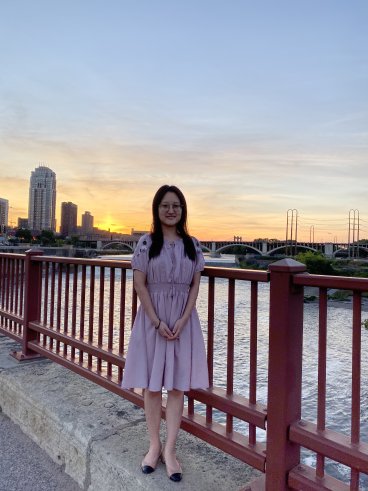Meet CTC: Jiaxin Ning

November 16, 2020 -- Jiaxin Ning is a third-year graduate student in Prof. Truhlar’s group. She graduated from Nankai University in Tianjin, China with a bachelor's degree in chemistry.
Jiaxin is currently working on the simulation of photodissociation – a chemical reaction in which a compound is broken down by photons – of 2-fluorothiophenol. Because of the unique role of the intramolecular hydrogen bond, photodissociation and internal relaxation of the 2-fluorothiophenol molecule provide a prototype for understanding substituent effects on the important σ pathway that is helpful in understanding photostability. Knowledge of this specific photodissociation process provides insight into other photochemistry phenomena. It is also helpful in synthesizing useful materials for solar cells and molecular motors.
Jiaxin uses the coherent switches with decay of mixing (CSDM) method in the SHARC program to do dynamics simulations. She uses the extended multi-state complete-active-space perturbation theory (XMS-CASPT2) in the BAGEL program to do electronic structure calculations.
Outside of research, Jiaxin enjoys cooking, reading novels and poems, watching movies, and spending time with her friends and family. She likes living in the Twin Cities because she thinks that the people are nice and helpful, and there are some good Chinese restaurants near the University of Minnesota campus.
How did you become interested in studying chemistry, and what gets you the most excited about your field?
In college, I chose chemistry as my major because I found that chemical reactions are fundamental to explaining biology, which I really liked. Then, I found the beauty of chemistry itself, especially computational chemistry. It allows me to use mathematical tools and laws of physics to explain not only biology, but also many other interesting real-life phenomena.

Why did you choose the University of Minnesota, and what led you to join your current research group?
I chose the University of Minnesota because of its reputation in chemistry. I joined Prof. Truhlar’s group mainly due to two people, Prof. Truhlar himself and a senior graduate student in the group, Jie Bao. I took Prof. Truhlar’s dynamics class in my first semester of graduate school, and I found he is a very nice and knowledgeable person. Jie Bao is also nice, as well as humorous. More importantly, I think both of them are doing research in a rigorous, but not rushed way, which I admire. This mindset is important because it allows them to be more certain that their findings are reliable and reproducible.
What has been your most interesting finding so far?
My most interesting finding is that when I calculate the excitation energies for 1,3-cyclohexadiene and 1,4-cyclohexadiene, Rydberg orbitals in the active spaces not only enable the calculation of Rydberg excitation energies, but they also make valence excitation energy calculations more accurate. People often ignore the importance of Rydberg orbitals, but my findings prove that they’re important to consider.
What drives you to be a better scientist?
My non-stop curiosity about the findings in my research process makes me keep going. To be a better scientist, I think working hard is very important. I believe in Richard Feynman’s quote saying: “I was an ordinary person who studied hard. There’s no miracle people.”
What advice do you have for aspiring scientists?
When you do research, you might face complicated systems, and you might find something that seems irrational at first glance. However, I think the fun part of research is using your intelligence to explore the rationality of the seemingly irrational results.
I compare science as a pathway towards the light in the darkness. Research is like building your own pathway on the basis of the well-established one and you might get lost now and then, but you eventually find the right way and get closer to the light. Learning mature theories is like walking on a pathway that has already been built.
